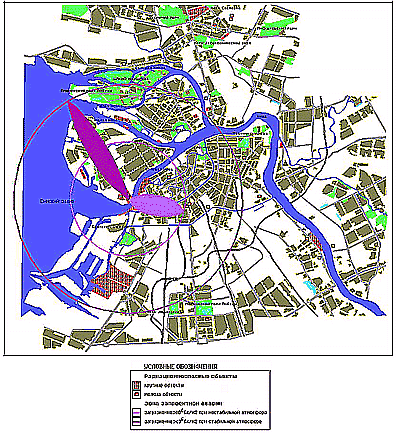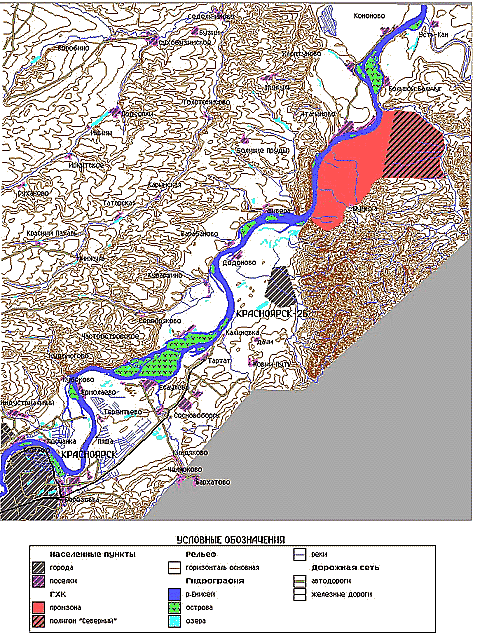Brief of contents of chapters.
Below short resume of the book chapters is given.
Preface.
In the preface the history of writing of the book as well as the objectives and main results of the project "RADARM" are presented. Main results obtained in the framework of the project are given in the form of regional geoinformation systems designed for the users of personal computers as well as in the form of hard copy reports on Russian and English. The chapters of the book were written using these reports.
Introduction.
REGIONAL DATA BASES
AND GEOINFORMATION SYSTEMS OF THE TERRITORIES OF RUSSIA.
In the introduction the importance of the work on generalisation
and analysis of great amount of scattered data is shown. It became
possible to collect and generalise this big volume of existing data
on radiation state of our environment and population health only
by using advanced information technologies.
Short information on approaches used for creation of
computer based information system and facilities
of developed system is given.
Chapter 1.

North-Western region of Russia
is characterised by the greatest variety of enterprises-sources of
radioactive contamination of the environment. Their total amount is
approaching to ten thousands and no less than one third of them are
dealing with tasks related to the activity of military-industrial
complex. Such situation has been set up historically since the very
beginning of the use of nuclear energy in the USSR and will remain
at least for a few tens of years more.
In the chapter the nuclear and radioactively dangerous
facilities in North-Western region related to the activity of military-
industrial production are listed. Mostly dangerous emergency situations
that are practically possible on some of listed facilities are
considered.
More over two local areas (test sites on Vasilievski island of
St-Petrsburg city and small area on the shore of Finski Bay near
Privetnenskoe settlement of Leningrad Oblast) were studied and major
approaches to remediation of these sites were developed.
Chapter 2.
In relation with the conversion of the enterprises of military industry in Russia the production of atomic submarines is over on the part of these enterprises. Meantime the number of serious issues arised with relation to the problem of decommission of used atomic power installations of nuclear submarines and ships, storage and disposal of radioactive wastes. Several years ago by the Decree of the President of Russian Federation the Centre of Atomic Ship Production had been established. It includes "Sevmashpredpriyatie" and ship repairing enterprises "Zvezdochka" and "Nerpa". In the chapter the results of the study of radioactive contamination of the environment on mentioned enterprises as well as on the repair-technological enterprise "Atomflot" dealing with technological service of civilian nuclear ships are presented.
Chapter 3.

Radioecological situation of Arctic region of Russia
to a great extent is defined by radioactive contamination of earth
caused by impact of tests of nuclear weapons on the Archipelago Novaya
Zemlya as well as by contamination of Nordic seas of North Ocean as
a result of dumping liquid radioactive wastes from radiochemical
plants of Western Europe and USSR, by Murmansk sea ship enterprise (???)
and North Fleet of USSR.
Potential threat of nuclear contamination of Kara Sea is due to
sea dumping solid radioactive wastes, nuclear reactors and spent
nuclear fuel.
Chapter 4.

The major impact on radiation state of the territory
of region arises from big objects of nuclear industry that by throws(???)
of radionuclides or by leakage of radioactive wastes result in serious
radioactive pollution of the environment having certain hazard for the
population of the region.
There are three major objects of atomic industry: Chemical-Mining
Combine (CMC) in the city Krasnoyarsk-26, Electrochemical Combine in
the city Krasnoyarsk-45 and research nuclear reactor in the city
Norilsk.
Chemical-Mining Combine acting for more then 35 years produces mainly
the weapon grade plutonium.
Many years activity of radiochemical production of CMC as well as
running of directly cooled by the water from the river Enisey
nuclear reactors following by dumping this water back to the river
resulted in the contamination of the river basin by radionuclides.
Chapter 5.
Production combine "Mayak" has grown from the first in the USSR
enterprise for industrial production of fission materials - Uranium
-235 and Plutonium-239 for nuclear bombs. Combine was built on South
Ural not far from old Ural towns Kyshtym and Kasli. On June 22, 1948
the first Uranium-Graphite reactor had been runned on the designed power.
Already at first day of its operation the serious accident happened.
Soon the second accident came. Liquidation of the consequences of
accidents resulted in the overirradiation of working staff and team
of liquidators.
In the further years on the combine the emergency situations had taken
place several times. One of them had led to radioactive contamination
of large areas on the north-east of nuclear plant. Used practice of
dumping radioactive waste into Techa river and lake Karachai gave rise
to the pollution of rive basin and practically destroyed lake Karachai
that transformed in the dangerous zone of radioactive disaster.
Chapter 6.
New data on radioecological problems of the territories surrounding
the enterprises of nuclear fuel cycle including Siberian Chemical
Combine (SCC) placed on the territory of Tomsk region near city Tomsk
are presented.
Since 1986 Russia faces more and more regional problems of
radioecological nature.
On the expression of Academician A.F.Tcyba on the parliament hearings
in the State Duma in 1994 year "...the population of Russia is one of
the most damaged by radiation throughout the world...".
When the information related to the nuclear weapons tests on the test
sites of the former Soviet Union (Semipalatinsk, Novaya Zemlya, Totsk
etc.), on the disasters on the enterprises of nuclear materials production
and military objects (Kyshtym, Chernobyl, Far East), on the radioactive
waste disposal, as well as publications on the assessment of the impacts
of nuclear tests, disasters and routine practice of bad management with
radioactivity began to appear it became clear, that the expression
of academician is based on the real facts and situations.
Chapter 7.
Far East as North-West of Russia is a region of concentration of nuclear submarines with their service bases and developed ifrastructure of production beginning from building and repair and finishing by decommission and dismounting. As a result we have the essential concentration of radioactive wastes and contamination of the environment by radionuclides. In the chapter the original information of Pacific Fleet and Gidromet Service of this region on systematisation and generalisation of long terms observations of radiation situation on the territories and aquatories close to repair plants of atomic submarines and bases of Pacific Fleet is given. Also the distribution of redioactive elements in the sea water of the Bay Peter The Great is reported.
Chapter 8.
Compiled data on the nuclear disaster in 1985 in Primorie reflecting radioactive contamination of this region and surrounding aquatories are presented. Short analysis of the dynamic of contamination is made and possible consequences because of new income of radioactivity released at dismounting 61 decommised atomic submarines and disposal of radioactive wastes is presented.
Chapter 9.

Various data of radioecological, medical-demographic, social-economic characters as well as data on technogenic contamination of the environment has been integrated by means of geoinformation technology. Developed computer based version of information system for integrated assessment and analysis of radioecological situation with application to Altai region served as a prototype for the information system of the project "RADARM" and might be useful for other ecological organisations to support solving the problems of ecological safety of the biosphere on regional and local levels.
Chapter 10.
Not everybody possibly knows that on the territory of the former
Soviet Union 113 research nuclear installations are running and it
being known that they are placed as a rule in such great cities as
Moscow and St-Petersburg.
The capital of Russia is actually an "epicenter" of atomic science.
In Moscow region now about a hundred of the objects of atomic industry
is under exploitation. One should add to this 1500 enterprises using
in their practice the sources of ionising radiation and radioactive
materials (including fission materials).
In the city with 10 million population like Moscow existence of such
great number of nuclear facilities is dangerous first of all because
the majority of these installations were born in the heat of the "Cold
War" when the requirements and rules of management with radiation did
not exist or they did not correspond to modern knowledge about the
impact of radiation on the human body.
Chapter 11.
The main terms of the radiation safety and dosimetery are presented. In short form the modern knowledge on the impact of penetrating radiation on the human organism is given.
Chapter 12.